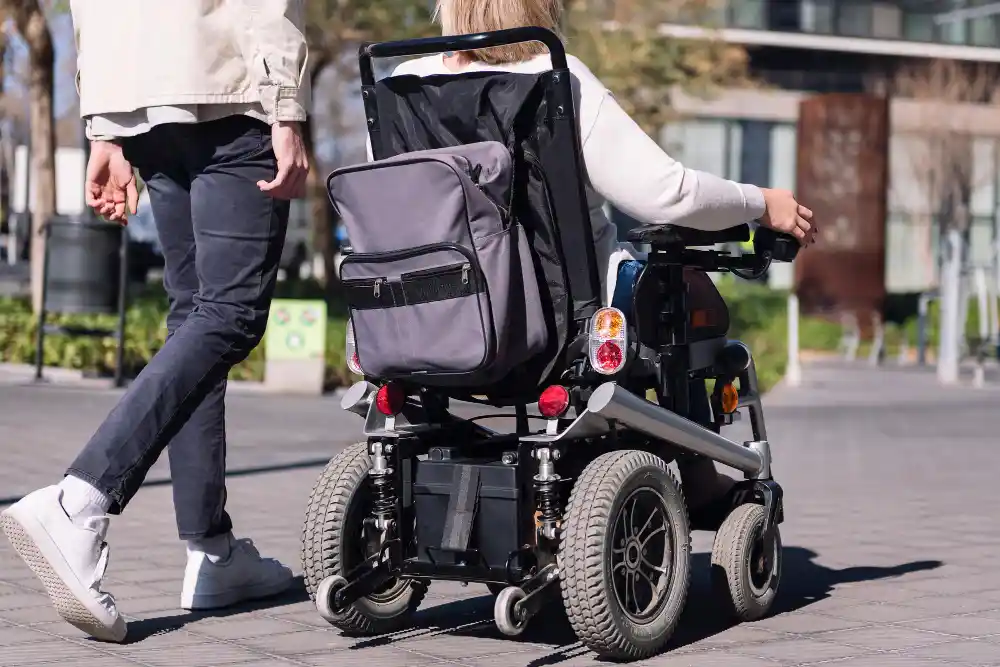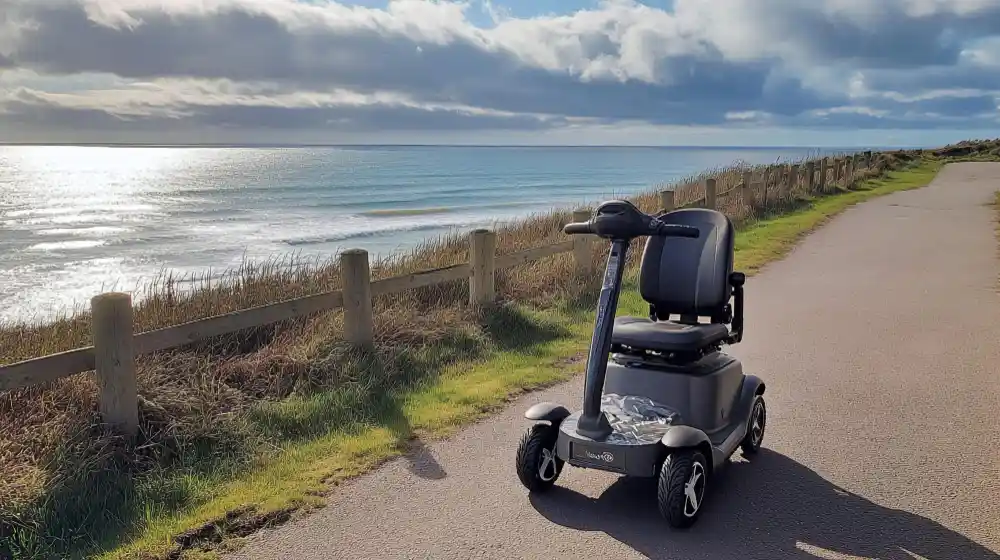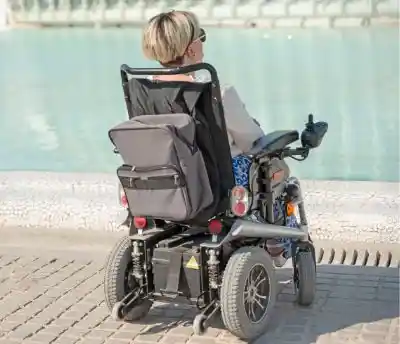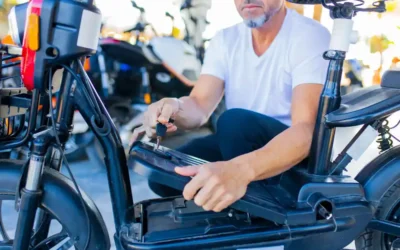Introduction
Choosing the right electric wheelchair is a significant decision that can greatly enhance mobility, independence, and quality of life for those with limited mobility. Electric wheelchairs, with their advanced technology and ease of use, offer a world of freedom, empowering users to move around comfortably and confidently. However, with so many models and features available, finding the right one tailored to individual needs can feel overwhelming.
This guide is here to simplify the process by breaking down all the essential factors to consider. From understanding your personal mobility requirements to evaluating specific wheelchair features, such as battery life, weight capacity, and maneuverability, we’ll walk through everything you need to know to make an informed decision. We’ll also explore the various types of electric wheelchairs, key accessories, and practical considerations like budget, warranty, and maintenance, so you can choose the model that aligns with your lifestyle.
Whether you’re looking for a wheelchair for indoor navigation, outdoor adventures, or a balance of both, this guide will help you find the best fit. Making the right choice means not only investing in mobility but also in daily comfort, independence, and peace of mind.

Assessing Your Personal Needs and Lifestyle
Choosing the right electric wheelchair begins with a deep understanding of your personal needs and lifestyle. Since everyone’s mobility requirements and daily routines vary, selecting a wheelchair that aligns with these unique factors can significantly impact your comfort, independence, and satisfaction. Here’s a breakdown of key considerations to help you assess your personal needs and lifestyle for the most suitable choice:
1. Mobility Requirements
Begin by evaluating your specific mobility needs. Electric wheelchairs vary greatly in terms of support levels, capabilities, and features, so consider:
- Physical Limitations: Think about the level of support required for both short- and long-distance mobility. Are there specific challenges, such as limited hand dexterity, that would affect your control preferences?
- Assistance Needs: Will you need the help of a caregiver? Certain models are more caregiver-friendly and allow for easier pushing or lifting if assistance is needed.
- Range of Use: For those needing mobility support throughout the entire day, a model with longer battery life and durable construction may be ideal.
2. Daily Activities and Environment
Your daily routine plays a vital role in the type of wheelchair you need. Consider where and how you plan to use the wheelchair to find one that seamlessly integrates into your lifestyle.
- Indoor vs. Outdoor Use: If you primarily use the wheelchair indoors, maneuverability, tight turning radii, and compact size will be essential. For outdoor usage, look for models with durable tires, a strong suspension, and weather-resistant features.
- Home Environment: Evaluate your living space. Tight doorways, narrow hallways, or high thresholds may require a more compact model with a smaller turning radius.
- Terrain: Smooth floors, carpets, and even surfaces suit lighter models, while rougher terrains like gravel, grass, or uneven sidewalks require a model with robust wheels and suspension.
3. Frequency and Duration of Use
Different electric wheelchair models cater to various levels of daily use, from occasional use to all-day reliance. Ask yourself:
- Usage Frequency: How often will you be using your wheelchair daily or weekly? If it’s only needed occasionally, a lighter, more portable model might work well. If you rely on it for most activities, choose a model with extra durability.
- Duration of Use: Extended use demands comfort-oriented features like supportive cushioning, adjustable footrests, and back support. Electric wheelchairs designed for long-term use also typically offer superior battery life, ensuring your mobility isn’t restricted by frequent recharging needs.
4. Lifestyle and Preferences
Electric wheelchairs offer various customizations to accommodate diverse lifestyles and preferences:
- Portability Needs: If you enjoy traveling or need to take your wheelchair on the go, prioritize models designed for portability. These models are often foldable, lightweight, and easy to store in vehicles.
- Comfort Preferences: For those who plan to spend extended hours in the wheelchair, comfort is key. Look for features such as memory foam seats, lumbar support, and adjustable armrests. Ergonomic seating and a well-designed backrest can make a significant difference in comfort over long periods.
- Style and Aesthetics: Electric wheelchairs come in various designs and colours, allowing you to select one that matches your personal style. Some models offer options for customising frames, upholstery, and accessories.

Types of electric wheelchairs
1. Travel/Portable Electric Wheelchairs
Travel or portable electric wheelchairs are designed for people who need mobility on the go. These wheelchairs are lightweight, foldable, and easy to disassemble, making them ideal for travel by car, train, or plane. While portable models are convenient and easy to transport, they often come with smaller batteries and less power, making them best suited for short trips and occasional use.
Key Features:
- Lightweight and foldable for easy transport
- Simple to disassemble and reassemble
- Typically limited in range and speed
- Best for short distances and infrequent use
Best For: Travelers or those needing a secondary wheelchair for outings or short trips.
2. Heavy-Duty Electric Wheelchairs
Heavy-duty electric wheelchairs are built to support higher weight capacities, typically up to 500 pounds or more. They are designed with robust frames, larger wheels, and powerful motors to navigate a variety of terrains. These models often have a larger battery capacity for extended range and can handle outdoor environments, including rough or uneven surfaces.
Key Features:
- Higher weight capacity and durable construction
- Suitable for rugged terrain and outdoor use
- Larger battery capacity for extended range
- Sturdy, but typically heavier and less portable
Best For: Users needing higher weight support or more rugged mobility solutions for outdoor use.
3. Power-Base Electric Wheelchairs
Power-base electric wheelchairs have their drive wheels positioned in the center, providing a balance between maneuverability and stability. This design is ideal for users who want to navigate both indoor and outdoor spaces seamlessly. The power-base design offers improved control, especially in tight spaces, and can typically be adjusted to accommodate different seating arrangements and ergonomic needs.
Key Features:
- Enhanced stability with centered drive wheels
- Improved maneuverability in tight spaces
- Versatile for both indoor and outdoor use
- Adjustable seating options for custom comfort
Best For: Those needing a versatile wheelchair for daily use in various environments.
4. Rear-wheel drive Electric Wheelchairs
Rear-wheel drive electric wheelchairs have wheels positioned at the back, providing stability and control, especially at higher speeds. These are powerful and suitable for outdoor use but may have a larger turning radius than center-wheel or front-wheel models, making them less ideal for tight indoor spaces.
Key Features:
- Stable and powerful for outdoor use
- Capable of higher speeds and longer distances
- Larger turning radius, less suitable for indoor navigation
- Generally better traction on uneven surfaces
Best For: Users who prioritize outdoor use and stability at faster speeds.
5. Front-Wheel Drive Electric Wheelchairs
Front-wheel drive electric wheelchairs have wheels positioned at the front, allowing them to tackle obstacles like small steps and curbs more easily. They provide good maneuverability for both indoor and outdoor environments but tend to have slower speeds than rear-wheel drive models. Front-wheel models can also handle rough terrain well, providing a smooth ride.
Key Features:
- Good maneuverability and obstacle handling
- Suitable for mixed indoor and outdoor use
- Generally slower speeds than rear-wheel models
- Smooth operation on varied terrains
Best For: Users navigating both indoors and outdoors, needing a wheelchair that can handle occasional obstacles.
6. Standing Electric Wheelchairs
Standing electric wheelchairs allow users to move from a seated to a standing position, providing health benefits like improved circulation, reduced muscle atrophy, and increased independence. These wheelchairs are equipped with motors to assist the standing movement, and they are ideal for users looking to engage more fully in social interactions or reach higher objects independently.
Key Features:
- Allows transition from seated to standing position
- Health benefits, including improved circulation and muscle tone
- Enhanced social and environmental interaction
- Typically more expensive and heavier
Best For: Users prioritizing health benefits and independence with a focus on versatility in daily activities.
7. Tilt-in-Space Electric Wheelchairs
Tilt-in-space electric wheelchairs allow users to tilt the entire seat backward without changing leg or back position. This design is beneficial for users needing pressure relief, as tilting helps redistribute weight and reduce the risk of pressure sores. These models are particularly useful for people who spend extended periods in their wheelchair.
Key Features:
- Seat tilts to redistribute pressure and prevent sores
- Beneficial for long-term users needing pressure relief
- Often includes additional comfort features
- Heavier and less portable than standard models
Best For: Individuals needing long-term seating with a focus on pressure relief and comfort.
8. All-Terrain Electric Wheelchairs
All-terrain electric wheelchairs are specially designed for outdoor enthusiasts. They feature powerful motors, larger wheels with better tread, and reinforced frames that can handle rugged terrains like sand, gravel, and snow. These wheelchairs are ideal for users wanting to explore natural settings or less accessible areas.
Key Features:
- Built for rugged, uneven terrain
- Reinforced frame and large, durable wheels
- Powerful motor with extended battery life
- Often bulkier and less maneuverable indoors
Best For: Users looking for outdoor adventure and exploration on various terrains.

Key Features to Consider
Selecting the right electric wheelchair requires attention to specific features that impact comfort, usability, and functionality. Here’s a breakdown of the most important features to consider:
1. Battery Life and Charging
- Battery Range: Battery life determines how far you can travel on a single charge. Wheelchair models vary in range, with typical models offering anywhere from 10 to 20 miles, while heavy-duty models may provide even more.
- Charging Time: Some models require longer charging times than others, so consider your daily schedule and when you can set aside time for charging.
- Battery Type: Most electric wheelchairs use sealed lead-acid or lithium-ion batteries. Lithium-ion batteries are lighter and have a longer lifespan but may cost more.
2. Weight Capacity
- Maximum Load: Each wheelchair model is designed to accommodate a specific weight capacity. Standard models generally support 250-300 pounds, while heavy-duty models can support up to 600 pounds.
- Frame Durability: Heavier users may need reinforced frames, which can handle additional weight without compromising stability.
3. Speed and Maneuverability
- Top Speed: Standard electric wheelchairs usually offer speeds between 4-5 miles per hour. Consider your need for speed based on the settings where you’ll be using the wheelchair.
- Turning Radius: The turning radius indicates how tight a space the wheelchair can navigate. A smaller turning radius is ideal for indoor use, where maneuverability around furniture or tight spaces is crucial.
- Drive System:
- Rear-Wheel Drive: Provides more power and stability, suitable for outdoor or uneven terrain.
- Mid-Wheel Drive: Allows for a smaller turning radius, ideal for indoor use.
- Front-Wheel Drive: Offers a balanced choice, maneuverable indoors and powerful enough for outdoor use.
4. Seat Size and Comfort
- Seat Width and Depth: Choose a seat width that’s comfortable and supportive without being restrictive. Seat widths generally range from 16 to 22 inches, with customizable options for different body types.
- Padding and Ergonomics: Long periods in the wheelchair require a comfortable seat cushion with sufficient padding. Ergonomic options and memory foam cushions add extra comfort and can help prevent pressure sores.
- Adjustable Features: Adjustable armrests, footrests, and headrests are essential for personalized comfort. Look for models where these features can be adapted to suit your posture and body shape.
5. Control Options
- Joystick Configuration: Joystick placement can be customized to either side of the armrest, depending on your dominant hand. It’s important that the joystick is responsive and easy to control.
- Specialized Controls: For users with limited hand mobility, some wheelchairs offer alternative control options such as sip-and-puff or head control systems, enhancing accessibility.
6. Portability and Storage
- Foldable Models: If portability is a priority, look for lightweight, foldable models that can easily fit in a car trunk. Some electric wheelchairs disassemble into smaller components, making transportation even easier.
- Storage Pockets and Holders: Built-in storage options, such as under-seat pouches or backrest pockets, can be useful for carrying personal items, medical supplies, or groceries.
7. Safety Features
- Anti-Tip Wheels: Most models come with anti-tip wheels that prevent the chair from tipping over backward on inclines or uneven surfaces.
- Seat Belts and Safety Harnesses: Essential for maintaining a safe position, especially when navigating uneven terrain.
- Lighting and Reflectors: If you plan to use the wheelchair in low-light conditions, choose a model with built-in lights or reflectors to increase visibility.
8. Terrain Compatibility
- Indoor vs. Outdoor Use: Wheelchairs designed for indoor use may have smaller wheels and a compact design, while outdoor models have larger, more durable wheels and a suspension system for handling uneven ground.
- All-Terrain Capabilities: If you expect to navigate rugged terrain or slopes, consider a model with larger wheels, enhanced suspension, and higher ground clearance.

Customization and Accessories for Electric Wheelchairs
Choosing the right electric wheelchair goes beyond selecting a model; customizing it to fit your unique needs and adding practical accessories can make all the difference in comfort, convenience, and independence. Here’s a closer look at the customization options and accessories available for electric wheelchairs:
1. Adjustable Features for Personalized Comfort
- Seat Adjustments: Many electric wheelchairs offer adjustable seat sizes, allowing for wider or narrower widths, as well as variations in seat depth to ensure proper posture and comfort. Custom seat cushions can also be added for those who require additional lumbar support or are prone to pressure sores.
- Recline and Tilt-in-Space: Wheelchairs with reclining or tilt-in-space features can adjust the seat’s angle, providing enhanced comfort for long periods of use. These features also help redistribute pressure, which is beneficial for users at risk of pressure ulcers.
- Footrest Adjustments: Footrests that can be extended, raised, or positioned at different angles allow users to adjust for leg length and mobility needs. Elevating footrests can aid in circulation and provide additional comfort for those with leg swelling or limited movement.
- Armrest Adjustments: Adjustable armrests provide the flexibility to modify arm height and position, making it easier to transfer in and out of the wheelchair or simply find the most comfortable resting height.
2. Convenience-Boosting Accessories
- Storage Pouches and Bags: Attachable storage options, such as under-seat pouches, side bags, or rear baskets, make it easy to keep essentials like medications, personal items, or shopping bags within reach.
- Cup Holders and Tray Tables: A cup holder can make carrying drinks safer and more convenient, while attachable tray tables are perfect for eating, working, or using devices on the go.
- USB Chargers: Some electric wheelchairs now come with USB charging ports, allowing users to charge phones, tablets, or other small devices directly from their wheelchair battery. This can be especially useful for individuals who rely on mobile devices for communication or navigation.
3. Safety and Visibility Accessories
- Lights and Reflectors: For outdoor use, especially in low-light conditions, lights and reflectors increase visibility and enhance safety. Many models offer LED light kits that can be attached to the front or back of the wheelchair.
- Rearview Mirrors: Rearview mirrors can improve visibility, especially when navigating crowded spaces or reversing. They’re a valuable addition for users who frequently use their wheelchairs outdoors.
- Seat Belts and Harnesses: Safety belts or full-body harnesses add a layer of security, particularly for those with limited torso control. These accessories help maintain stability while navigating uneven terrain.
4. Weather Protection
- Waterproof Covers: A waterproof cover protects the wheelchair from rain, snow, and dust when not in use. It’s a simple but effective way to extend the wheelchair’s lifespan, especially if frequently used outdoors.
- Rain Canopies: Canopies or rain shields can be attached to provide head-to-toe protection against the elements, ensuring users stay dry and comfortable even in inclement weather.
5. Specialized Supports and Medical Accessories
- Headrests and Lumbar Supports: Custom headrests and lumbar supports provide additional comfort for users with specific posture needs or spinal conditions.
- Oxygen Tank Holders: For those who require supplemental oxygen, oxygen tank holders can be securely attached to the wheelchair, ensuring easy access without compromising mobility.
- IV Pole Attachments: For users undergoing continuous medical treatments or infusions, IV pole attachments are available for some electric wheelchair models. These provide a convenient way to carry necessary medical equipment while maintaining mobility.

Practical Considerations
When investing in an electric wheelchair, it’s essential to think beyond just the features and assess the practical aspects that will impact your day-to-day use, budget, and the long-term usability of the wheelchair. Here are key practical considerations to keep in mind:
1. Budget and Financing Options
- Price Range: Electric wheelchairs vary widely in cost, typically ranging from a few thousand to over ten thousand dollars, depending on the features, type, and brand. Understanding your budget helps you narrow down your options.
- Features vs. Cost: While budget models may seem appealing, it’s essential to ensure they meet your needs, especially in areas like battery life and durability. Sometimes, a higher initial investment in a quality model can lead to lower maintenance costs and longer usability.
- Financing Options: Many wheelchair suppliers offer financing or payment plans that allow you to spread the cost over several months or years. Additionally, some organizations and nonprofits provide financial assistance for those needing mobility aids.
- Insurance Coverage: In some regions, insurance may partially or fully cover electric wheelchairs if deemed medically necessary. Check with your insurance provider to see if you qualify for reimbursement or coverage on certain models.
2. Warranty and Customer Support
- Warranty Terms: A robust warranty is crucial as it offers peace of mind and covers repair costs if there are issues with your wheelchair. Look for a warranty that covers at least one year for parts and labor. Some manufacturers also offer extended warranties.
- Customer Service: Having reliable customer support is invaluable, especially when facing technical issues or needing repair guidance. Research brands known for responsive and helpful customer service, as this can greatly affect your overall experience.
- Local Repair Centers: It’s practical to consider whether there are authorized repair centers nearby or if the supplier offers in-home service. A model with limited repair options might be challenging to maintain if issues arise.
3. Maintenance Requirements
- Battery Maintenance: Batteries are essential to an electric wheelchair’s functionality. Regularly charging and following battery care instructions are vital for longevity. Some batteries require replacement every 1-2 years, so factor in these recurring costs.
- Tire and Part Replacement: Certain wheelchairs have specialized tires or parts that may wear out over time, particularly if you frequently use the wheelchair outdoors. Ensure replacement parts are accessible and affordable.
- Routine Cleaning and Care: Keeping your wheelchair clean, especially around the control panel, wheels, and motor area, can prevent issues down the line. Follow the manufacturer’s recommendations for regular cleaning, particularly if the wheelchair is used outdoors.
4. Storage and Portability
- Storage Space at Home: Consider the wheelchair’s dimensions and ensure you have adequate space to store it when not in use. For those with limited space, compact or folding models might be more convenient.
- Transporting the Wheelchair: If you travel frequently, look for a model that is lightweight, foldable, or easily disassembled. Many electric wheelchairs can fit in the trunk of a car or come with removable batteries to make transport easier.
- Weight Limitations on Lifts or Ramps: If you plan to use a vehicle lift or ramp, make sure it’s compatible with the wheelchair’s weight. Some heavier models may exceed the capacity of standard lifts, requiring an upgrade or specific vehicle modifications.
5. Resale Value
- Longevity and Brand Reputation: Some electric wheelchairs hold their value better due to durability, brand reliability, and demand. Investing in a well-regarded brand or model can be beneficial if you plan to upgrade or sell the wheelchair in the future.
- Condition Maintenance: Keeping your wheelchair in good condition with regular maintenance and prompt repairs can help retain its resale value, should you decide to sell it later.
Testing and Reviewing Options
Choosing the right electric wheelchair is a significant decision, and before making a purchase, it’s crucial to test and review various models. Testing and reading reviews can help you identify which features will work best for your daily routine, comfort, and long-term needs. Here’s how to approach this essential part of the selection process:
1. Test Driving Different Models
a. Visit Local Retailers or Showrooms
- Many mobility stores and wheelchair retailers allow customers to try out electric wheelchair models on-site. Take advantage of this opportunity to get a feel for different models.
- When visiting, try to test wheelchairs in spaces that mimic your own environment (tight turns for indoor use, ramps for outdoor capability) to see how well each model meets your specific needs.
b. Assess Maneuverability and Turning Radius
- Test the wheelchair’s turning radius and overall maneuverability. This is particularly important if you’ll use it indoors or in tight spaces, like narrow hallways or small rooms.
- Try making sharp turns and navigating around obstacles to gauge ease of use and control.
c. Evaluate Comfort and Adjustability
- Comfort is critical, especially if you’ll be using the wheelchair for extended periods. Sit in the chair for at least 10–15 minutes to evaluate the seat padding, back support, and overall fit.
- Test adjustable features, such as seat height, armrest position, and footrest angle, to ensure they provide the right level of customization and comfort.
d. Try Out the Control System
- Experiment with the joystick or alternative control options to see how intuitive and responsive they feel. Ensure the controls are accessible and comfortable for extended use, particularly if you have limited hand mobility.
- Test speed adjustments, braking, and any additional control functions to ensure they’re easy to operate and suit your needs.
2. Renting an Electric Wheelchair for a Trial Period
- Some companies offer rental programs for electric wheelchairs, allowing you to “test drive” a model over several days or weeks. This is especially helpful if you’re new to electric wheelchairs and want to see how a particular model fits into your daily routine.
- Look for rental options that allow you to upgrade to a purchase if you decide the wheelchair is right for you, as this can save time and money.
3. Checking Online Reviews
a. Prioritize User Experiences
- Look for reviews from users who share similar needs and preferences, as they can provide valuable insights into real-world performance. For example, if you need an outdoor-capable model, look for feedback on how the wheelchair handles rough terrain or various weather conditions.
- Consider the average user satisfaction and note any recurring praise or complaints.
b. Consider Professional Reviews
- Some websites and organizations offer professional reviews and comparisons of electric wheelchair models, often including objective criteria like battery life, weight capacity, durability, and ease of use.
- These reviews can be helpful for understanding the technical details and broader performance metrics of different models.
c. Watch Video Demonstrations and Walkthroughs
- Video reviews or walkthroughs on platforms like YouTube can provide a visual understanding of the wheelchair’s features and how it performs in real settings.
- Seeing the wheelchair in action and listening to users explain the pros and cons can give you a clearer sense of its functionality.
4. Seeking Recommendations and Advice
a. Consult with Healthcare Professionals
- Occupational therapists or mobility specialists often have experience with different wheelchair brands and models and can recommend specific features based on your mobility needs.
- A healthcare professional’s advice can be especially valuable if you have unique requirements, such as limited hand strength, advanced postural support needs, or a particular medical condition.
b. Join Online Forums and Support Groups
- Joining forums and groups for electric wheelchair users can help you gather unbiased feedback and tips from real users.
- Fellow users can often provide advice on maintenance, feature hacks, and which models are best for particular environments or challenges.
Conclusion
Choosing the right electric wheelchair is a significant decision that can greatly impact your comfort, mobility, and independence. By carefully assessing your personal needs, understanding the various wheelchair types, and weighing essential features like battery life, weight capacity, and manoeuvrability, you can make an informed choice that enhances your daily life.
It’s also crucial to consider practical aspects such as budget, warranty, and available customisation options to ensure you find a wheelchair that not only fits your lifestyle but can adapt as your needs evolve. Don’t hesitate to test different models and read reviews to get a well-rounded view of your options.
Remember, the right electric wheelchair should feel like an extension of you, providing the freedom to navigate your world with confidence and ease. With thoughtful planning and research, you’ll be able to select a model that supports your journey and empowers you to live life to the fullest.



